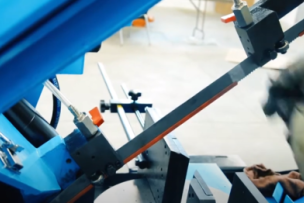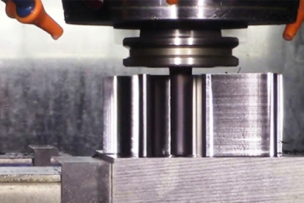Hi, I'm Mike Grosenbach product specialist for distributed products at Mitutoyo America Corporation. Today I'm joined by Dakoda Pollitt, who is a CNC machining student in the Chicago area I guess and we get a lot of questions at Mitutoyo concerning inside measurement, inside diameter measurement, and ID gauges. There's a lot of different gauges out there depending on your application, accuracy requirements, and budget and all these choices can get overwhelming. So today we're going to give a little bit of insight on the different types of gauges with a focus on two contact style gauges in hopes of eliminating some of this confusion. And today we're going to talk about an overview of how they work, the setup, and the usage of these types of gauges.
So the first gauge we'll talk about our telescoping gauges. So I assumed you've used these before? Yes, actually my personal set that I use in class. Alright, so basically what these are they're two contacts that are spring-loaded so you can put it down into the bore and inside diameter and then once you've picked up the diameter you can lock it down with this nut that's set into the handle.
So for example, how would you use this to measure a cylindrical bore like this? First it kind of going at an angle then I rock it back and forth until I kind of feel it grab and then I lock it down. Okay and one of the things to check with this is after you've locked it down swing it back and forth again to make sure that you've picked up the actual diameter. If you feel like catching then that means that you've probably locked it down at a far false large reading so you're not reading, you're not measuring the actual diameter of the bore and after that we're gonna take it to our micrometer and measure the telescoping gauge.
So here you're going to measure it in different places and make sure that you're picking the maximum reading of this bar as it's being setting in the micrometer. If you're measuring something that's smaller, if it's at a slight angle, you're going to get a smaller dimension which is going to be inaccurately small. So our teacher told us to do it three times then get the average, so I'll do it the second time. Okay, so these are fairly common gauges – they're in a lot of different shops, they're really inexpensive and after you've taken it out, measured a bore, you measure the telescoping gauge with a micrometer which every machine shop is going to have.
It's a good idea to do it three times just because it is a little bit trickier there's a little bit more feel to it so when you're making sure that you're picking up the ID measurement of the bore yeah so we added eight ten thousandths on this one eight ten sire okay so and as you're seeing here - there's a lot of potential sources of air with these. There's no live reading when you're putting it into the inside diameter so you do have to put it down and get a feeling for it, lock it down, and measure it. And because it doesn't have a live reading you do have to measure it and verify your measurement and the gauge is also then measured by a micrometer which is another source of error in itself and it's slightly difficult to line up the telescoping gauge between the contact surfaces of the micrometer. If you don't have it perfectly lined up again you're gonna get a false small reading on the telescoping gauge.
Is there a more accurate way to measure other than the telescoping gauge? Absolutely, the next step up would probably be the dial bore gauge. I have used one of these before. I've noted what makes it different than the telescoping gauges. Well basically what this is it's a comparison gauge with on the head you've got a solid or fixed anvil and a spring-loaded anvil that translates the motion up through the bore gauge to the dial indicator that's located at the top. There's also a spring-loaded centering mechanism here which tends to center itself in the bore and normally these would be set up with a master part or a setting ring or a micrometer or even a bore gauge setting tool.
One reason why it's better is that you can actually see the minimum reading being picked up on the dial face and it's easy to get a feeling for where the actual diameter is in the bore. So let's go ahead and set this up. So we've set our micrometer to our nominal, which in this case is three point zero seven. So when you're setting up between the faces again, you've got these two spherical faces on the bore gauge and the two flat faces on the micrometer, so you're going to want to make sure that once they're placed in between the faces that you do a sweep back and forth to make sure that you're picking up the minimum reading and then also twist the head back and forth to make sure that after you've picked up the min. reading one dimension you you're picking up the minimum reading and the other as well okay? Okay, so let's go ahead and measure this board here then. All right, so I'm kind of doing it similar to the telescoping gauge similar telescoping yeah so you're gonna put the gauge in, swing it back and forth and see what the minimum reading on the dial face is. So it's on the eight graduation okay. On the 8th graduation so this is a one tenth graduation indicator so eight graduations would equate to then eight ten thousandth of an inch in thousands of an inch and it's on the plus side of the zero point. So comparison type gauge zeroed out eight tenths high. So that means that you'll add that on to the nominal of what you set it up with. So it'll be three point zero seven zero eight inches for the actual bore diameter. Let's say we wanted to see the out of round of the board to see if there was any OV ality to it. For example, so let's go ahead and if we put it in and now rotate it about ninety degrees as a sample from where we previously measured it and then take another measurement of the bore yeah so this one is at nine ten thousand this time okay so it's nine ten thousand so this would give it since this is one ten thousands different from our previous measurement. There's about one tenth out of round four this bore so this was definitely easier to use.
Is there anything else I should be kind of looking for while using it? Yeah absolutely, it is still a bit subjective because you do have to look at the minimum reading on the dial display so different operators could look at that a little bit differently. One could see eight tenths, one could see nine tenths, or that it's in between, there is also a little bit of parallax error between the needle and the dial face and also the grads could be misread. This is a one tenth graduation indicator, but for example if you had a 5/10 graduation indicator, if you read five graduations on that, wrote down five tenths actually that was two and a half now of variance between those. Also, it's a mechanical gauge so the data off of this would need to be written down and maybe typed in later which also introduces transcription errors.
So how do you overcome some of the challenges we face with the dial indicator? Absolutely. One way of doing that would be to use a digital indicator. This one specifically is designed for bore gauges. So what's nice about it is it has three presets and it also has a minimum hold mode so once it's in the bore gauge you can put it down in the bore, hit the start button, and sweep it and it'll automatically pick up the diameter of the part. It also has a tolerance mode where you can at a glance see if it's in or out of spec, high or low, and it has output.
So if we wanted to send the data to a computer you could do that wired or wirelessly. So let's start by setting this up in a setting ring. So you put it in, hit the start button, and then sweep it by the diameter after it's picked up that minimum reading code and hold down the preset button for a couple seconds. And we've already entered the preset value of the setting ring which is three point zero zero zero two five. Let's go ahead hit OK and now the bore gauge is set up. It has the setting ring value automatically assigned to that minimum reading or bore gauge reading. So now we're ready to measure the bore. So we'll put it in, measure as normal. Go ahead and hit the start button to start it off okay. You'll sweep it by the peak value. I noticed that as those same analog bar as the dial indicator. Exactly, so it'll still give you a visual representation just like a dial indicator so it also helps with the feeling of the gauge. She showed me a couple different styles of the two point gauges. Are there any other different types? Yeah, absolutely. There's also the three contact style which have three pins in a head. These are a direct reading type gauge. They also have a longer stroke than a typical bore gauge and these are typically used for tighter tolerances and they tend to seat themselves in the bore with just minor positioning. There are two types of these gauges, the Mike head style as well as the spring-loaded style. They use the same measuring heads but the Borematic is nice because you can use it in different orientations it's very quick. So if you wanted to take a measurement here you can also rotate the face to measure in a different orientation. Some people though do still prefer the micrometer head style because of stability. Okay, so once you try this out on this board, measure this alright so you see that he's positioned it in the bore and with minimal posit repositioning, he's already measuring the inside diameter.
Thanks Mike, I learned a lot today. People have questions or suggestions for future videos what should they do for questions and suggestions use the comments below or to schedule a demo call 888-MITUTOYO or visit www.mitutoyo.com.



